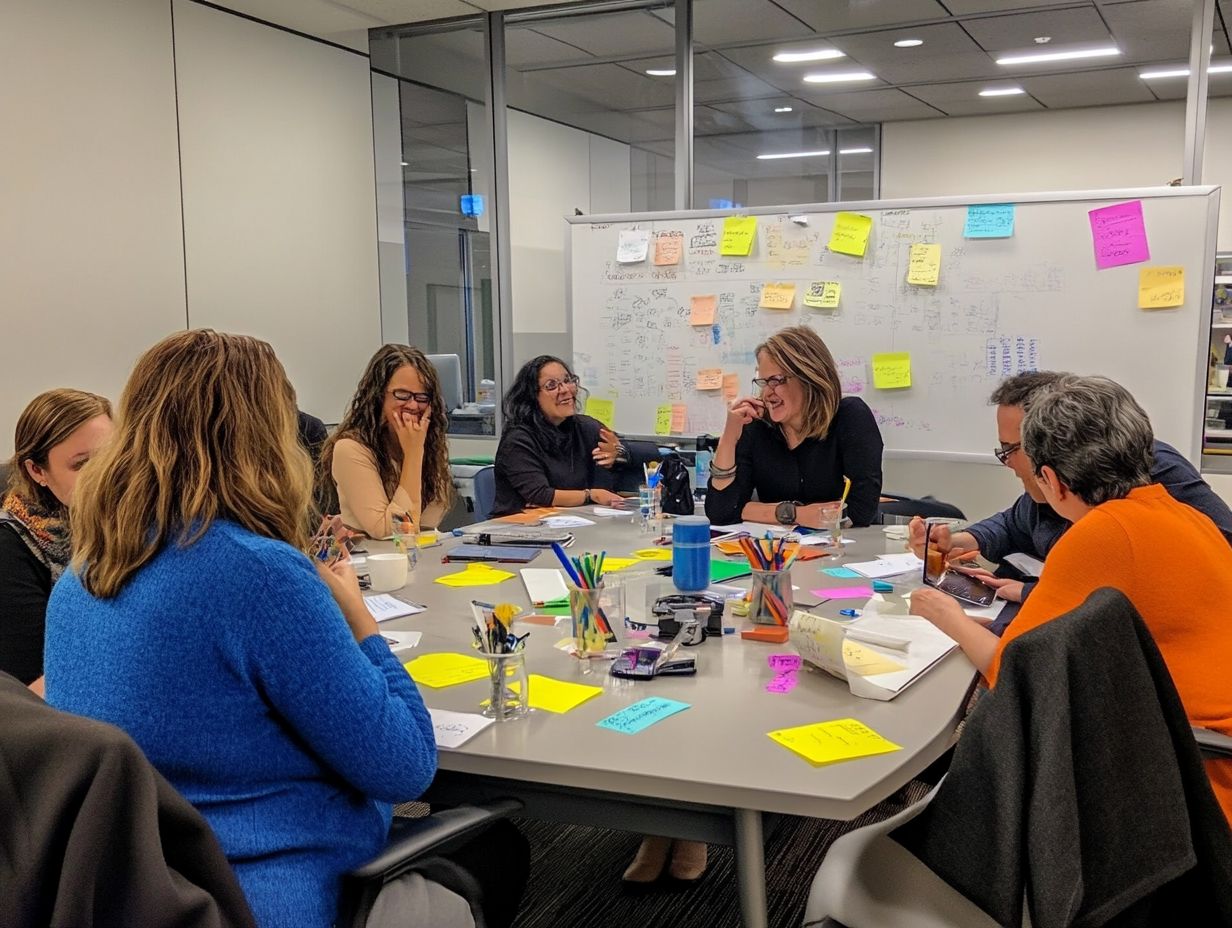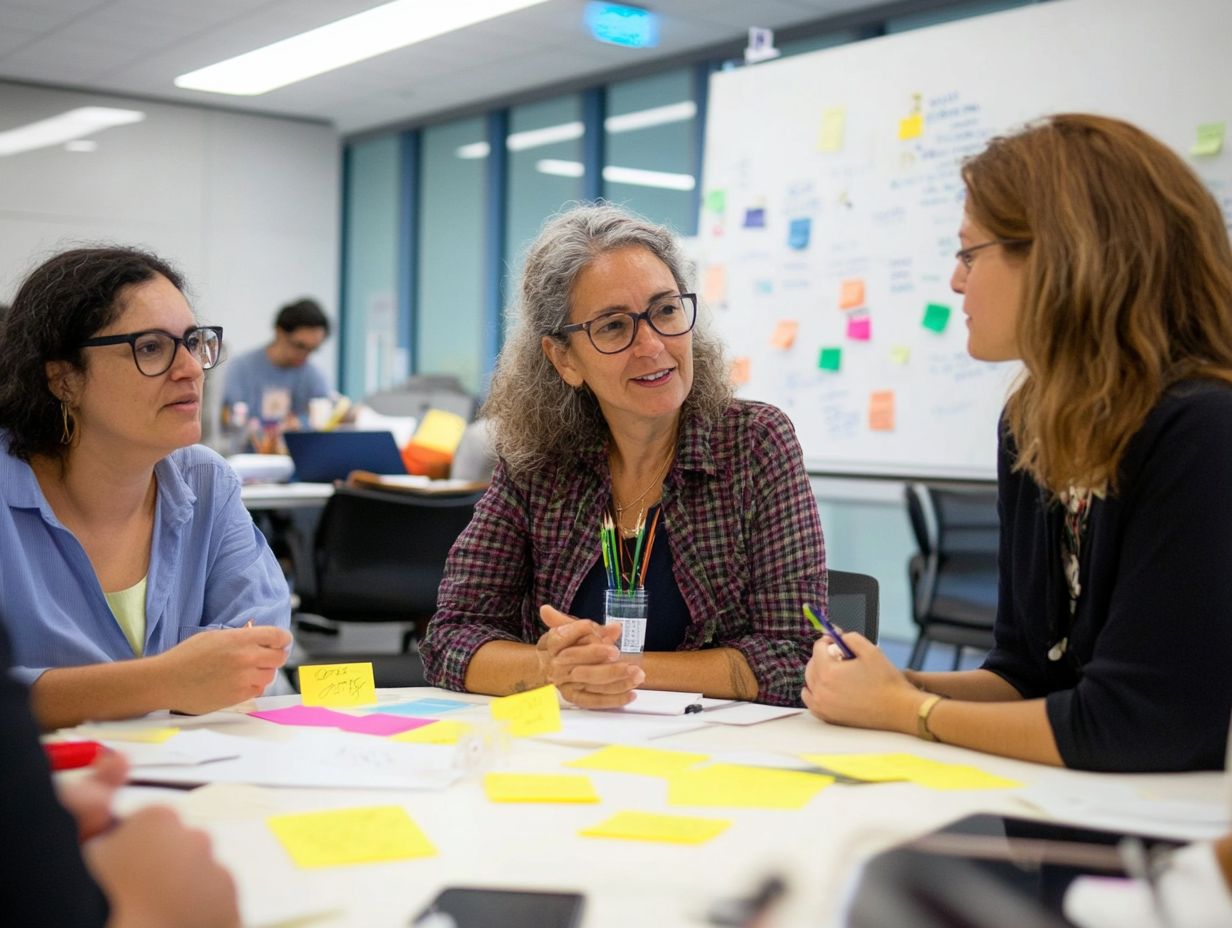5 Effective Techniques for Creative Brainstorming
Brainstorming goes beyond just trendy terms; it stands as a formidable tool capable of unlocking creativity and encouraging new ideas.
You ll discover five effective techniques Mind Mapping, Reverse Brainstorming, Random Word Association, Role-Playing, and the SCAMPER Technique, which helps you to think about how to change existing ideas into new ones that can help you generate fresh ideas.
We’ll explore common challenges, offer tips for effective team collaboration, and discuss the diverse applications of brainstorming across various industries. You’ll also receive practical tips to enhance your brainstorming sessions.
Get ready to boost your creative thinking now!
Contents
- Key Takeaways:
- 1. Mind Mapping
- 2. Reverse Brainstorming
- 3. Random Word Association
- 4. Role-Playing
- 5. SCAMPER Technique
- How Can Brainstorming Help with Creativity?
- What Are the Common Challenges in Brainstorming?
- How Can a Team Effectively Brainstorm Together?
- What Are the Benefits of Using Multiple Brainstorming Techniques?
- How Can Brainstorming Be Used in Different Industries?
- What Are Some Tips for Effective Brainstorming Sessions?
- Frequently Asked Questions
Key Takeaways:
- Use mind mapping to organize ideas visually.
- Try reverse brainstorming for a new perspective on problems.
- Use random word association for unexpected ideas.

1. Mind Mapping
Mind mapping serves as a powerful brainstorming technique that visually organizes information, giving you the power to generate ideas and navigate the creative process with clarity and structure.
By employing tools like Lucidchart and other brainstorming applications, you can transform complex thoughts into easily digestible formats. This facilitates effective idea generation and enhances clarity while fostering collaboration.
In various industries from marketing to engineering you can leverage mind mapping for:
- Project planning
- Capturing customer feedback
- Developing innovative product strategies
For example, a marketing team might utilize this technique to outline campaign themes, visualizing connections between target audiences and messaging concepts. Its visual nature cultivates a collaborative environment, allowing participants to contribute ideas in real-time.
This method also welcomes different viewpoints, making it easier to identify knowledge gaps and comprehend how different concepts interrelate. Ultimately, this leads to more knowledge-based decision-making and a stronger foundation for success.
2. Reverse Brainstorming
Reverse brainstorming invites you to embrace a fresh approach that pushes you to think critically by pinpointing potential problems rather than merely seeking solutions. This innovative method encourages you and your team to dive deep into various pitfalls and obstacles, ultimately paving the way for creative solutions that may have slipped under the radar otherwise.
Consider the tech industry: a team might delve into all the ways a new app could fail, leading them to develop a robust strategy for addressing user concerns. In healthcare, this technique can unveil potential risks in patient care, setting the stage for enhanced safety protocols.
Unlike traditional brainstorming, which tends to fixate on generating ideas, reverse brainstorming shifts the spotlight. It gives your team the power to anticipate challenges and craft innovative responses that proactively tackle those concerns.
3. Random Word Association
Random word association is a compelling brainstorming technique that ignites your creativity by linking seemingly unrelated words to spark fresh ideas and concepts.
This approach encourages you to step outside your comfort zone and explore new perspectives, often resulting in groundbreaking brainstorming outcomes.
By engaging in exercises like ‘Word Swapping’ where you and your team exchange a word from your lists to inspire one another or ‘Random Word Storytelling,’ you can create narratives around the random words you choose, uncovering connections that may have otherwise gone unnoticed.
Games like Word Association Chains keep the energy vibrant and the ideas flowing. Integrating randomness into your brainstorming sessions not only cultivates a dynamic atmosphere but also enhances collaboration, propelling your team toward innovative solutions that challenge traditional boundaries.
4. Role-Playing

Role-playing is a compelling brainstorming technique that invites you to step into different personas. This enhances group discussions and deepens your understanding of diverse perspectives.
By immersing yourself in various characters or scenarios, you can unlock innovative ideas that might otherwise remain hidden in standard conversations.
For instance, in a creative writing workshop, you might channel historical figures like Mahatma Gandhi. This allows you to explore his motivations and struggles, crafting unique narratives centered on resilience and non-violent change.
In corporate settings, companies like Toyota build teamwork through role-playing. They allow employees to simulate customer interactions. This practice sharpens problem-solving skills and enhances empathy among team members.
Such dynamics cultivate creativity and promote collaboration, ultimately leading to groundbreaking solutions.
5. SCAMPER Technique
The SCAMPER technique is a go-to brainstorming tool that encourages you to think beyond the ordinary. It applies various actions to existing ideas, paving the way for innovative solutions.
This method has seven key components: Substitute, Combine, Adapt, Modify, Put to another use, Eliminate, and Reverse. Each can be seamlessly integrated into a variety of scenarios.
For example, in product development, consider substituting a material to create a more sustainable version of your product. In marketing, combining two different campaigns can enhance engagement and broaden your audience reach.
Adapting an existing service for a new market can open significant growth opportunities. Modifying features of a digital tool can elevate user experience, while discovering new uses for an outdated product can spark renewed interest.
Eliminating unnecessary steps in a process streamlines efficiency. Reversing traditional workflows may reveal innovative solutions to age-old challenges.
These strategic actions inspire fresh perspectives and empower you to tackle challenges effectively across multiple domains.
How Can Brainstorming Help with Creativity?
Brainstorming is essential to your creative journey. It unleashes your imagination and generates a wealth of ideas that elevate creativity across various fields.
This practice cultivates a sense of community and collaboration, promoting diverse thinking and breaking down barriers within your organization.
By employing effective brainstorming techniques like mind mapping, which visually organizes ideas, and rapid ideation, you can enhance this creative exchange. These techniques guide discussions and maintain a seamless flow of ideas.
Integrating collaborative AI tools can amplify your idea generation. They enable you to analyze vast data sets for inspiration and offer unique perspectives.
Companies like IBM and Google have successfully embraced these methodologies, leading to innovations that distinguish them in competitive markets.
These exciting examples show how structured creative processes can lead to breakthrough ideas that drive your business forward!
What Are the Common Challenges in Brainstorming?
Common challenges in brainstorming often arise from social barriers and ineffective collaboration. These issues can prevent you and your team from fully harnessing collective creativity during sessions.
Barriers can take many forms, such as vocal participants overshadowing quieter team members. The fear of judgment can create an environment where individuals hesitate to share ideas, stifling creativity.
To combat these issues, adopting a structured approach can be immensely beneficial. Techniques like round-robin sharing ensure everyone has an equal opportunity to contribute.
Fostering a culture of open-mindedness helps create an inclusive environment. This allows innovative thoughts to emerge and thrive.
How Can a Team Effectively Brainstorm Together?

For your team to truly excel in brainstorming sessions, it s vital to create an environment that fosters open dialogue and optimizes the use of brainstorming tools.
Consider implementing techniques like round-robin sharing, where every member has the chance to express their ideas without interruptions. This ensures that everyone s voice is valued!
Utilizing collaborative tools such as Google Docs can streamline this process. Participants can capture thoughts in real-time, so no idea slips through the cracks.
Platforms like Lucidspark elevate your collaboration, enabling team members to visually map out concepts interactively. Mind mapping software acts as a visual anchor, helping to systematically organize thoughts. This can lead to richer and more productive brainstorming sessions.
Encouraging all voices to be heard nurtures creativity and sparks innovation.
What Are the Benefits of Using Multiple Brainstorming Techniques?
Using multiple brainstorming techniques can elevate your idea generation process. It enables you to explore diverse perspectives and unearth creative solutions to complex challenges.
Incorporating methods like mind mapping, role-playing, and the SCAMPER method creates a more dynamic and inclusive atmosphere.
- Mind mapping: Visually organize your thoughts and reveal connections between ideas that might not be immediately obvious.
- Role-playing: Step into different personas to yield unexpected insights and foster empathy among team members.
- SCAMPER method: This involves substituting, combining, adapting, modifying, putting to another use, eliminating, and reversing ideas, which can lead to groundbreaking innovations.
A tech startup recently exemplified this approach during a product development workshop. They successfully merged these techniques to create a unique app feature that dramatically boosted user engagement.
How Can Brainstorming Be Used in Different Industries?
Brainstorming stands as a versatile tool that you can adapt easily across various industries, from tech to healthcare. It enhances your problem-solving capabilities and drives innovation.
Take the automotive sector as an example. Companies like Toyota harness brainstorming sessions to tackle complex challenges, such as streamlining production processes and enhancing vehicle safety features.
These collaborative meetings often generate creative solutions that not only resolve immediate manufacturing hurdles but also align with long-term sustainability goals.
In healthcare, brainstorming proves invaluable for addressing issues like optimizing patient care and allocating resources efficiently. Engaging diverse teams opens the door to unique perspectives, leading to enhanced strategies targeting sector-related problems.
The dynamic nature of brainstorming fosters an environment where breakthrough ideas can flourish, potentially making a significant impact across various fields.
What Are Some Tips for Effective Brainstorming Sessions?
To ensure your brainstorming sessions are successful, implementing effective strategies can greatly enhance collaboration, spark creativity, and lead to innovative solutions.
First and foremost, setting a clear goal is essential. It provides the direction and focus that guide the discussion.
Encourage participation from all voices, ensuring that even the quieter members feel valued and heard.
Incorporating various brainstorming tools, such as flowcharts and fishbone diagrams, can help visualize ideas and systematically identify potential issues.
Creating a supportive environment is crucial. When participants feel safe expressing their thoughts without the fear of criticism, they re more likely to share bold and unconventional ideas.
Together, these practices contribute to a more dynamic and productive brainstorming experience, elevating the quality of your discussions.
Frequently Asked Questions

What are the 5 effective techniques for creative brainstorming?
The 5 effective techniques for creative brainstorming are: mind mapping, reverse brainstorming, role-playing, random word association, and the SCAMPER method.
Start implementing these techniques today and watch your ideas flourish!
In summary, effective brainstorming requires an environment that encourages all voices, utilizes varied techniques, and fosters collaboration across industries. Share your brainstorming experiences with us!
How Can Mind Mapping Help with Creative Brainstorming?
Mind mapping is a visual brainstorming technique. It creates a diagram of ideas, letting your thoughts flow freely.
What is Reverse Brainstorming?
Reverse brainstorming helps identify problems related to a topic. Then, it focuses on finding creative solutions to overcome them.
How Does Role Playing Contribute to Creative Brainstorming?
Role playing allows you to act out scenarios related to a problem. This helps you think from different perspectives and generate unique ideas.
What is Random Word Association?
Random word association uses a random word to spark new ideas. This technique helps break mental blocks and encourages creative connections.
What is the SCAMPER Method?
SCAMPER stands for Substitute, Combine, Adapt, Modify, Put to another use, Eliminate, and Reverse. It helps improve existing ideas by encouraging creative changes.






